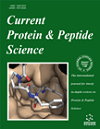- Home
- A-Z Publications
- Current Protein and Peptide Science
- Previous Issues
- Volume 17, Issue 1, 2016
Current Protein and Peptide Science - Volume 17, Issue 1, 2016
Volume 17, Issue 1, 2016
-
-
Protein Structure and Function: Looking through the Network of Side-Chain Interactions
More LessAuthors: Moitrayee Bhattacharyya, Soma Ghosh and Saraswathi VishveshwaraNetwork theory has become an excellent method of choice through which biological data are smoothly integrated to gain insights into complex biological problems. Understanding protein structure, folding, and function has been an important problem, which is being extensively investigated by the network approach. Since the sequence uniquely determines the structure, this review focuses on the networks of non-covalently Read More
-
-
-
Are Proteins Just Coiled Cords? Local and Global Analysis of Contact Maps Reveals the Backbone-Dependent Nature of Proteins
More LessAuthors: Daniele Santoni, Paola Paci, Luisa D. Paola and Alessandro GiulianiIn this work, we present an extensive analysis of protein contact network topology applied to a wide data set. We extended the concept of degree distribution to graphlets, describing local connectivity patterns. We compared results to those derived from artificial networks of the same size (number of nodes), reproducing the average degree of each protein network. The artificial networks resemble the coiling of immaterial Read More
-
-
-
Exploring the stability of dimers through protein structure topology
More LessAuthors: Luisa D. Paola, Giampiero Mei, Almerinda Di Venere and Alessandro GiulianiProtein homodimers pose some intriguing questions about the relation between structure and stability. We approached the problem by means of a topological methodology based on protein contact networks. We correlated local interface descriptors with structure and energy global properties of the systems under analysis. We demonstrated that the graph energy, formerly applied to the analysis of unconjugated hydrocarbons Read More
-
-
-
Topological Analyses of Protein-Ligand Binding: a Network Approach
More LessProteins can be conveniently represented as networks of interacting residues, thus allowing the study of several network parameters that can shed light onto several of their structural and functional aspects. With respect to the binding of ligands, which are central for the function of many proteins, network analysis may constitute a possible route to assist the identification of binding sites. As the bulk of this review illustrates Read More
-
-
-
Amino acid network for prediction of catalytic residues in enzymes: a comparison survey
More LessAuthors: Jianhong Zhou, Wenying Yan, Guang Hu and Bairong ShenCatalytic residues play a significant role in enzyme functions. With the recent accumulation of experimentally determined enzyme 3D structures and network theory on protein structures, the prediction of catalytic residues by amino acid network (AAN, where nodes are residues and links are residue interactions) has gained much interest. Computational methods of identifying catalytic residues are traditionally divided into two Read More
-
-
-
Functional heterogeneity as reflected by topological parameters in a classical protein molecular model: t4 phage lysozyme.
More LessAuthors: Lisa Beatrice Caruso, Alessandro Giuliani and Alfredo ColosimoA systematic comparison with the Wild-Type (WT) of one-point mutants of bacteriophage T4 lysozyme was carried out using as difference markers the topological parameters of the protein contact networks corresponding to each crystallographic structure. The investigation concerned changes at the resolution level of single residue along the protein sequence. The results were correlated with (reported) changes in functional pr Read More
-
-
-
The Semantics of the Modular Architecture of Protein Structures
More LessAuthors: Jose S. Hleap and Christian BlouinProtein structures can be conceptualized as context-aware self-organizing systems. One of its emerging properties is a modular architecture. Such modular architecture has been identified as domains and defined as its units of evolution and function. However, this modular architecture is not exclusively defined by domains. Also, the definition of a domain is an ongoing debate. Here we propose differentiating structural, evoluti Read More
-
-
-
Analysis of protein-protein interaction networks based on binding affinity
More LessAuthors: K. Yugandhar and M. Michael GromihaAnalyzing protein-protein interaction (PPI) networks has been a crucial prerequisite for understanding the molecular basis for most of the diseases. Although several investigations have been carried out on PPI network analysis, none of them explicitly considered binding affinity as a criterion for the analysis. In this work, we have performed a systematic analysis of protein-protein interaction networks in five organisms based on th Read More
-
-
-
Multi-scale modularity and motif distributional effect in metabolic networks
More LessAuthors: Shang Gao, Alan Chen, Ali Rahmani, Jia Zeng, Mehmet Tan, Reda Alhajj, Jon Rokne, Douglas Demetrick and Xiaohui WeiMetabolism is a set of fundamental processes that play important roles in a plethora of biological and medical contexts. It is understood that the topological information of reconstructed metabolic networks, such as modular organization, has crucial implications on biological functions. Recent interpretations of modularity in network settings provide a view of multiple network partitions induced by different resolution parameter Read More
-
Volumes & issues
-
Volume 26 (2025)
-
Volume 25 (2024)
-
Volume 24 (2023)
-
Volume 23 (2022)
-
Volume 22 (2021)
-
Volume 21 (2020)
-
Volume 20 (2019)
-
Volume 19 (2018)
-
Volume 18 (2017)
-
Volume 17 (2016)
-
Volume 16 (2015)
-
Volume 15 (2014)
-
Volume 14 (2013)
-
Volume 13 (2012)
-
Volume 12 (2011)
-
Volume 11 (2010)
-
Volume 10 (2009)
-
Volume 9 (2008)
-
Volume 8 (2007)
-
Volume 7 (2006)
-
Volume 6 (2005)
-
Volume 5 (2004)
-
Volume 4 (2003)
-
Volume 3 (2002)
-
Volume 2 (2001)
-
Volume 1 (2000)
Most Read This Month
Article
content/journals/cpps
Journal
10
5
false
en


